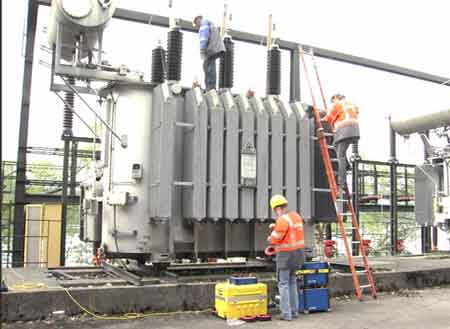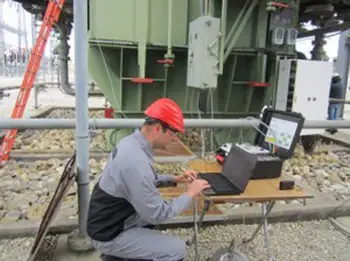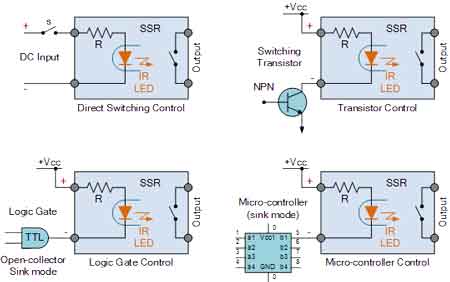Transformer Sizing Explained
By R.W. Hurst, Editor

Substation Maintenance Training
Our customized live online or in‑person group training can be delivered to your staff at your location.

- Live Online
- 12 hours Instructor-led
- Group Training Available
Download Our OSHA 3875 Fact Sheet – Electrical PPE for Power Industry Workers

- Follow rules for rubber gloves, arc-rated PPE, and inspection procedures
- Learn employer obligations for testing, certification, and training
- Protect workers from arc flash and electrical shock injuries
Transformer sizing ensures electrical transformers are properly matched to load demand, primary voltage, and secondary voltage. Correct sizing enhances efficiency, prevents overload, and ensures reliable operation in industrial power distribution.
What is Transformer Sizing?
Transformer sizing is the process of selecting the correct capacity and voltage ratings to meet electrical load requirements while ensuring safe, efficient, and reliable power delivery.
✅ Matches transformer kVA to load demand
✅ Ensures proper primary and secondary voltage
✅ Prevents overloads and efficiency losses
Electrical Transformer Maintenance Training
Substation Maintenance Training
Request a Free Training Quotation
Understanding transformer sizing is crucial for achieving optimal electrical system performance, ensuring safety, and maximizing efficiency. By considering factors such as capacity, kVA rating, load calculation, voltage ratio, primary and secondary windings, impedance matching, efficiency, temperature rise, and short-circuit current, it is possible to select the ideal size for a specific application. Working with an experienced electrical contractor or using a reliable calculator can help streamline the sizing process and ensure the most accurate results. When selecting typical transformer sizes, it is helpful to review the typical sizes used in various applications to ensure the proper selection of kVA.
Selecting the right-sized transformer for your electrical system is critical to ensuring efficiency, safety, and reliability. Proper sizing requires careful consideration of several factors, including capacity, kVA rating, load calculation, and voltage ratio. This article will examine these elements in detail and address some of the most frequently asked questions about selecting the correct unit size for various applications. For distribution-level applications, accurate sizing often involves selecting the appropriate distribution transformer to strike a balance between efficiency, safety, and system reliability.
One crucial aspect of selecting the right unit is understanding its capacity. This refers to the amount of power a unit can safely handle without overheating or causing system disruptions. Knowing the transformer's kilovolt-ampere (kVA) rating is crucial for determining the appropriate capacity. The kVA rating measures the transformer's apparent power, which combines both active and reactive power. This rating indicates the maximum power that a transformer can handle. Industrial load demands may require a properly sized three-phase transformer to handle balanced and unbalanced loads effectively.
FREE EF Electrical Training Catalog
Download our FREE Electrical Training Catalog and explore a full range of expert-led electrical training courses.

- Live online and in-person courses available
- Real-time instruction with Q&A from industry experts
- Flexible scheduling for your convenience
The next step in the sizing process is a load calculation. It involves determining the total electrical load that the system or equipment requires to be powered by the unit. This can be calculated using a kVA calculator or by consulting an experienced electrical contractor. Load calculation is crucial to ensure the device can supply sufficient power without overloading, which could lead to equipment failure and even hazardous situations.
Voltage ratio, another essential factor, refers to the ratio of the input voltage (primary voltage) to the output voltage (secondary voltage) in the unit. The voltage ratio is directly related to the number of turns in the primary and secondary windings, which affects performance. Therefore, selecting the appropriate voltage ratio based on the equipment's power requirements is essential to avoid over- or under-voltages. Utility engineers often reference substation transformers when determining appropriate sizing for high-voltage to medium-voltage conversions.
The primary and secondary windings play a vital role in transformer sizing. This is because primary windings are connected to the power source, while secondary windings supply power to the load. Therefore, ensuring the correct number of turns in each winding based on the voltage ratio is crucial for optimal performance and efficiency.
Impedance matching is a vital factor when sizing transformers. It involves ensuring that the impedance of the primary winding matches the impedance of the secondary winding to avoid power losses and ensure efficient power transfer between the input and output circuits.
Efficiency is another critical aspect to consider when selecting a unit size. Efficiency is determined by the ratio of its output power to its input power. A higher efficiency indicates less power is lost in heat, resulting in better performance and reduced operating costs.
The temperature rises and the short-circuit current also influence the sizing process. The temperature rise increases due to the handling load. Excessive temperature rise can cause insulation degradation and reduce lifespan. On the other hand, short-circuit current refers to the maximum current that flows through the unit when a short circuit occurs. Proper sizing helps to ensure that the device can withstand the effects of short-circuit currents without damage.
Frequently Asked Questions
How do you calculate the correct size of a transformer?
Calculating the correct size of a unit involves determining the load voltage, the load required, the kVA rating, and the voltage ratio. An electrical contractor or kVA calculator can help you with these calculations. Understanding construction is vital to proper sizing, and our guide on transformer components explains the role of cores, coils, and windings.
What factors should be considered when selecting a size?
When selecting a transformer size, several factors must be considered, including capacity, kVA rating, load calculation, voltage ratio, primary and secondary windings, impedance matching, efficiency, temperature rise, and short-circuit current.
What are the consequences of choosing an incorrectly size?
Consequences of choosing an incorrectly sized transformer include reduced efficiency, increased energy costs, potential damage to equipment, and safety hazards. In power distribution networks, selecting the correct medium-voltage transformer size ensures both operational safety and cost efficiency.
How do primary and secondary winding voltages affect sizing?
Primary and secondary winding voltages affect sizing by influencing the voltage ratio, which determines the number of turns in the windings.
How does impedance matching impact sizing?
Impedance matching impacts sizing by ensuring efficient power transfer between the input and output circuits, thus preventing power losses and enhancing overall performance.
How does efficiency influence size selection?
Efficiency influences size selection as higher-efficiency units can handle more power with less energy loss, resulting in better performance and reduced operating costs.
Test Your Knowledge About Electrical Transformers!
Think you know Electrical Transformers? Take our quick, interactive quiz and test your knowledge in minutes.
- Instantly see your results and score
- Identify strengths and areas for improvement
- Challenge yourself on real-world electrical topics
How does the temperature rise and short-circuit current affect sizing?
Temperature rise and short-circuit current affect sizing because excessive temperature rise can cause insulation degradation, reducing the lifespan. In contrast, proper sizing ensures the device can withstand short-circuit currents without damage.
Please pay close attention to the abovementioned factors to ensure the correct unit size is chosen. Also, consulting with an experienced electrical contractor or using a transformer sizing calculator is highly recommended to make the most informed decision.







